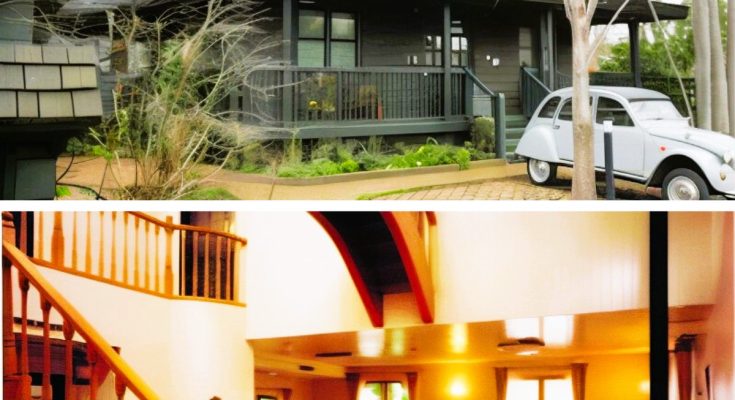
A few blocks from Studio Ghibli’s headquarters in Koganei City, Tokyo, stands the home of Hayao Miyazaki.
The house, designed by the legendary animator himself, reflects the European-style architecture that frequently appears in his films.
Unlike many celebrity residences, it remains completely open to the public eye, with no fences or barriers obstructing the view.
Over the years, Miyazaki has often been seen walking from his home to the studio, dedicated to his craft even in the later stages of his career.
At one point, even Google Maps cameras captured an image of him heading to work, adding to the mystique of his unassuming yet iconic residence.
A Home That Mirrors His Creations
Miyazaki’s home is more than just a place to live; it embodies the aesthetic and philosophy of his animated worlds.
The structure bears similarities to the Ghibli Museum and Studio Ghibli itself, both of which were also designed under his direction.
His deep appreciation for Western architectural styles is evident, with details reminiscent of the homes in films like Howl’s Moving Castle and Kiki’s Delivery Service.
Despite its fame, the house remains remarkably unguarded.
This openness mirrors the warmth and accessibility that define his works.
The residence is affectionately known as Buta-ya, or “Pig House,” a playful reference to his fondness for pig characters, as seen in Porco Rosso.
The Nibariki House and Studio Ghibli Connection

In 1998, Miyazaki designed and built a separate house nearby for his production company, Nibariki.
The name, meaning “two horsepower,” serves as a tribute to his favorite car, the Citroën 2CV, which remains parked outside as a nostalgic symbol.
This vehicle famously appeared in the car chase sequence of Lupin III: The Castle of Cagliostro, one of Miyazaki’s earliest directorial works.
The Nibariki house is a continuation of his signature style, blending whimsical design with functionality.
It has also served as a backdrop for interviews and behind-the-scenes glimpses into his creative process.
Alongside this home, Miyazaki has contributed to the architecture of other Ghibli-related buildings, including a nursery for studio employees and the NTV Grand Clock, a large-scale animated structure that embodies his intricate storytelling.
Explore More Photos Below
Small traditional structures with sloped roofs nestle among lush greenery, featuring intricate woodwork and aged exterior walls that harmonize with the garden’s natural elements.

The grand entrance framed by deep-hued wood paneling leads up a brick-lined pathway, where an inviting porch offers a tranquil transition into the serene residence.

Towering trees with lush foliage partially conceal a charcoal-hued home, while a vintage Citroën parked nearby enhances the rustic charm of the quiet retreat.

A secluded porch with dark wood paneling overlooks vibrant greenery, where aged shingles and antique fixtures add character to the peaceful setting.

The sweeping wooden staircase curves through an airy interior, complemented by natural light filtering through high windows and warm-toned wood flooring accentuating the open layout.

A softly lit dining space with handcrafted wooden chairs surrounds a sturdy table, where rustic textures and ambient lighting create an inviting atmosphere for thoughtful gatherings.

Floor-to-ceiling windows framed by pale curtains allow verdant scenery to flood the upper loft, while a gracefully curved balcony enhances the architectural fluidity of the space.

A handcrafted wooden railing follows the contours of an elegantly curved hallway, where warm lighting highlights the polished hardwood floors and gently arched doorways.

A Life Dedicated to Animation

Born in Tokyo in 1941, Hayao Miyazaki showed an early interest in animation and storytelling.
He began his career at Toei Animation in the 1960s, working on projects like Lupin III and Future Boy Conan before making his directorial debut with The Castle of Cagliostro in 1979.
In 1985, he co-founded Studio Ghibli, launching a series of beloved films that would define modern animation.
His works, including My Neighbor Totoro, Spirited Away, and Princess Mononoke, are celebrated for their rich storytelling, breathtaking animation, and environmental themes.
Despite multiple retirement announcements, his passion for animation has always drawn him back.
His most recent film, The Boy and the Heron, released in 2023, reaffirmed his status as a master storyteller.
A House That Reflects a Legendary Career
Miyazaki’s home stands as a testament to the imagination and dedication that have shaped his career.
It is a physical extension of the worlds he creates—welcoming, full of character, and deeply personal.
As he continues to inspire animators and filmmakers across the world, his home remains a quiet yet powerful symbol of his enduring legacy.



